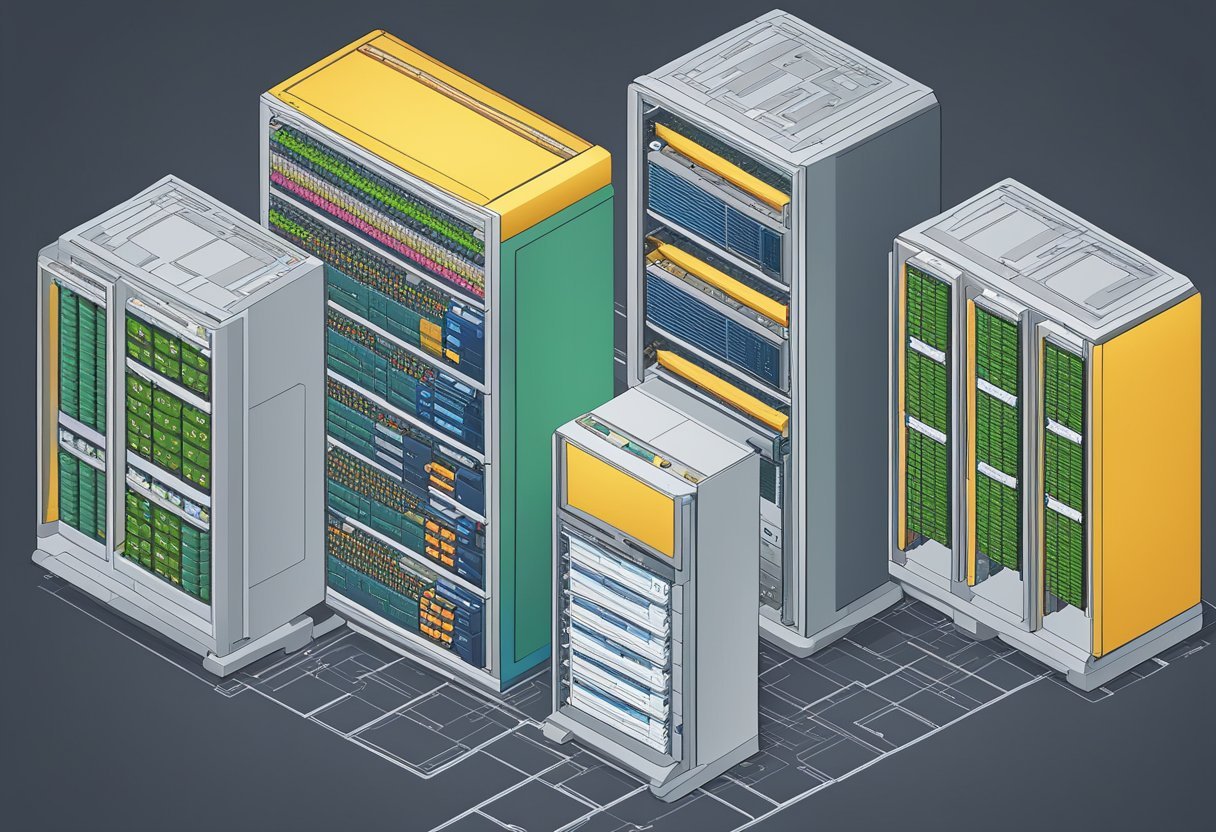Understanding Data Types
Data types define how data is stored, manipulated, and represented in computing.
Recognizing different categories like integers, floating-point numbers, and binary data ensures proper data usage.
Precision varies across types, influenced by specific application needs, impacting accuracy and performance.
Definition and Importance of Data Types
Data types are fundamental in programming and database management. They specify the nature of data and dictate how operations like arithmetic or sorting are performed.
Using the correct data type improves efficiency and minimizes errors in code.
For example, an int (integer) handles whole numbers, which is optimal for counting objects. In contrast, a float represents real numbers, suitable for precise calculations like scientific measurements.
Choosing these properly is crucial as it affects performance and storage requirements across applications.
Correctly choosing data types also ensures the integrity of the data. Mistakes in assigning types can lead to errors or data loss.
Consequently, understanding these types enhances the reliability of software systems.
Data Type Categories
Data types are often divided into several main categories, each serving a specific purpose.
Primitive types include basic types like int, char, and float. These are the building blocks in many programming languages.
Compound types such as arrays and structs allow handling multiple values or complex data.
Abstract data types like stacks and queues aid in structure and storage, especially in algorithms.
Other categories include pointer types for memory management and binary data for handling non-text data.
Recognizing these categories helps developers in selecting the appropriate type based on a task.
Libraries and frameworks often provide additional support for these, enhancing function and performance in various applications.
Exact vs. Approximate Numeric Data Types
Numeric data types fall into two primary categories: exact and approximate.
Exact numeric types include integers and decimal types. These convey full precision, making them ideal for counts and monetary computations where precision is crucial.
In contrast, approximate numeric types like float and double allow fractional values but with some degree of imprecision.
They are often used in scientific calculations where the precision required can be limited due to their wide range and speed.
Understanding the distinctions ensures the right balance between precision and performance.
Applications like financial systems demand exact types, whereas scientific models may prioritize speed, using approximate numerics where small errors are acceptable.
Integers and Their Variants
Integers in programming are used to store whole numbers, which include positive, negative, and zero values. They come in various sizes to handle different ranges of data efficiently, enabling developers to choose the right size depending on the application’s needs.
TinyInt, SmallInt, Int, BigInt
In many programming environments, integer types vary by size and range.
TinyInt is the smallest, often storing values from 0 to 255. It’s useful when memory is limited or when only small numbers are needed.
SmallInt is larger, typically holding values from -32,768 to 32,767. This type is a good choice for programs where slightly larger numbers are needed without consuming much memory.
The regular Int, or Integer, is perhaps the most commonly used. It usually stores values from about -2 billion to 2 billion, making it versatile for most operations.
For significantly large numbers, BigInt can be used. It can store enormously large values, well beyond the range of Int, making it ideal for applications like financial calculations or science applications where very large numbers are processed.
Integer Data Types Usage
Choosing the right integer type depends on the specific needs of an application.
TinyInt is often used for efficiency when dealing with small ranges like counters or flags. This helps save memory and improve performance.
SmallInt is suitable for situations where numbers aren’t too large. It’s common in smaller datasets or systems with limited resources.
Int is the default choice for many programs due to its ample range, making it suitable for most everyday calculations and operations.
When dealing with high precision and very large numbers, BigInt is vital. It’s frequently used in databases for IDs or in fields like cryptography, where exact large numbers are essential.
Decimal and Numeric Types
Decimal and numeric data types are used in SQL to store numbers with exact precision. They are chosen when calculations need to be exact, rather than approximate. With these types, you control precision and scale, making them ideal for financial and accounting applications.
Precision and Scale
Precision refers to the total number of digits that a number can have, while scale specifies how many of those digits can be to the right of the decimal point.
For example, a decimal(5,2) would allow numbers up to 999.99. The precision must be between 1 and 38, and the scale must be no greater than the precision.
These settings ensure accurate storage for numerical data, which is crucial in fields that require precise calculations.
Fixed Precision and Scale Data Types
The term “fixed precision” is used because the total number of digits and their location relative to the decimal point does not change.
In SQL, both decimal and numeric types are considered exact numeric data types.
This means they store values exactly as specified, unlike floating-point types, which might introduce tiny errors due to their storage method.
These data types are typically used in situations where the mantissa, integral part, and fractional part need to be precisely defined.
Rounding and Truncation
Rounding and truncation occur during arithmetic operations if the result exceeds the defined precision or scale.
Rounding adjusts the value to fit, often using a rule to round up or down, while truncation simply removes excess digits.
SQL provides functions to manage these behaviors, allowing developers to choose how numbers should be rounded or truncated.
Understanding how these processes work is essential to avoiding unexpected results, especially in financial computations where exact values are crucial.
For instance, the ROUND function can control decimal places, enabling precise adjustments necessary in specific applications.
Floating-Point Types
Floating-point types are used to represent real numbers in programming. They are essential for computations that require a trade-off between range and precision. This section explores the characteristics of real and float data types, and the precision involved in floating-point types.
Real and Float Data Types
The terms “real” and “float” refer to numeric data types used to approximate real numbers in computing.
Float, or single precision, typically uses 32 bits to store values, while double precision uses 64 bits, offering greater precision and allowing for a wider range of values.
Real data types are vital in calculations that handle very small and very large numbers, which require fast processing.
With floats, programmers can represent numbers like 3.14159 or 0.00001. However, because of the way floats are stored, they can only be approximations, which might lead to precision errors.
Understanding these types can aid in choosing the correct data type for a specific problem, especially in applications requiring high accuracy, such as scientific computations or financial calculations.
Precision in Floating-Point Types
Precision in floating-point types is crucial for the accurate representation of numbers.
These types represent numbers using three main components: sign, exponent, and mantissa.
The mantissa gives the floating-point number its precision, determining how accurately a number can be represented. The number of bits in the mantissa affects maximum precision.
Single precision, with fewer bits in the mantissa, offers less accuracy than double precision.
Access to floating-point precision is often limited by the IEEE 754 standard, which defines formats for representing and calculating these types consistently across systems.
Understanding how precision may impact calculations helps programmers avoid precision issues in their code, ensuring that operations are reliable and meet the application’s requirements.
Character Strings

Character strings in programming are essential for handling text. They come in various types, which are designed to optimize storage and performance for different needs. Key types include char, varchar, and Unicode-based strings like nchar and nvarchar, used to efficiently handle both regular and international characters.
Char and VarChar
Char and varchar are data types used to store non-Unicode string data.
Char is fixed-length, meaning it always uses the amount of space specified, regardless of the actual string length. If a field is defined as char(10), it uses 10 bytes even if the string is shorter.
Varchar, on the other hand, is variable-length. It only consumes as much space as needed to store the string. For example, varchar(10) can handle strings up to ten characters long, but will only use space for the actual length of the string.
This makes varchar efficient when storage space is a consideration.
Both types are essential when defining database schemas, as they help balance performance and data size. In C programming, char is also used to store single characters, as highlighted in information about character data types.
Unicode Character Strings
Unicode character strings like nchar and nvarchar are designed to store international characters, supporting the Unicode standard.
Nchar is similar to char but uses two bytes per character, allowing for a wider range of characters. It is fixed-length.
Nvarchar is like varchar but also supports Unicode. It is variable-length, making it suitable for languages with complex characters.
For strings that include different language scripts, nvarchar ensures that all characters are represented accurately.
These Unicode types improve globalization features in programming, allowing applications to handle a wide variety of languages. Using these types ensures proper encoding and display of text across various platforms, as noted in discussions on data types in programming.
Binary and Large Object Data Types
Binary and large object data types are essential for storing various forms of unstructured information. These include formats like binary and varbinary, which handle smaller binary data, and larger types for images and multimedia content.
Binary and VarBinary
Binary and varbinary are used to store small binary data.
Binary data types are fixed in size, meaning they reserve storage space for a defined number of bytes regardless of actual content size. Varbinary, on the other hand, is more flexible, storing variable-length data with a defined maximum size.
These types are ideal for files that need to be stored in their original binary form. Databases use these to store information like small file uploads or metadata that is easier to handle when kept in binary format.
The use of binary and varbinary is common in industries where precision and compactness in data representation are key.
Image and Other Large Value Types
Large value data types handle extensive data beyond the limits of standard data types. Examples include images, videos, and audio files. These are often stored as large objects (LOBs).
Within databases, these data types can effectively manage multimedia and other significant data payloads.
For instance, binary large objects (BLOBs) are specifically used for handling long strings of binary data like multimedia objects and programs.
They offer flexibility by accommodating data too large for regular types, essential in sectors relying on multimedia.
Proper use of these types allows data systems to efficiently manage and retrieve substantial amounts of unstructured data.
Date and Time Data Types
Date and time data types in SQL are used to handle data related to dates and times with precision and format variations. These types offer diverse capabilities to represent just dates, just times, or both.
Date, Time, DateTime, and Variants
Date types store only the date in the format yyyy-MM-dd, such as 2024-11-26. They are useful when time is not needed and they cover a range from 0001-01-01 to 9999-12-31.
Time handles time separately, storing only the time of day. It’s useful for logging hours, minutes, and seconds.
DateTime includes both date and time. It allows users to store a complete timestamp in one field, such as 2024-11-26 13:45:30.
Variants like DateTime2 offer more precision, and SmallDateTime uses less storage with a lower precision level. DateTimeOffset adds time zone support, vital for global applications.
Specialized SQL Server Data Types
SQL Server offers various data types designed to handle specific kinds of data. These specialized types include structured data types for complex data and unique identifiers that serve specific functions in databases.
Structured Data Types
SQL Server provides structured data types to manage complex structures. geography and geometry are used for spatial data. They let users store data such as maps or GPS coordinates. These types are crucial for applications requiring spatial awareness, like tracking locations.
hierarchyid is another structured type. It helps represent hierarchical data like organizational charts. It efficiently manages data hierarchies and supports querying to find relationships within the hierarchy.
sql_variant allows storing different data types in a single column. This flexibility is useful when dealing with mixed data types, making it a versatile choice for dynamic applications.
Identifiers and Reference Types
SQL Server uses identifiers to uniquely mark rows and objects. The uniqueidentifier type is a 16-byte value used to generate globally unique identifiers (GUIDs). This is helpful in databases with distributed architectures, ensuring unique entries across different systems.
The cursor type references a pointer for database rows. It’s used to process individual rows in a set, allowing fine-grained control over queries. bit is another reference-oriented type, used for binary data, typically representing true/false values efficiently.
These identifiers and reference types enhance SQL Server’s ability to manage data precisely and uniquely. money and smallmoney are two types used for handling currency values with fixed precision, suitable for financial applications needing accuracy over large and small monetary amounts.
Working with SQL Tables
In SQL, tables form the backbone of databases, structuring data in a clear format. Creating and managing tables effectively ensures data is organized, secure, and easily accessible.
Table Creation and Management
Creating a table in SQL involves defining columns and data types. The CREATE TABLE statement is essential for this. It specifies column names, types, and constraints to ensure valid entries. For example:
CREATE TABLE employees (
id INT PRIMARY KEY,
name VARCHAR(100),
position VARCHAR(50)
);
Once tables are established, managing them is crucial. The INSERT INTO command adds data, while DROP deletes tables when no longer needed. Consistent management helps in maintaining an efficient database system.
Data Integrity and Normalization
Data integrity ensures data accuracy and reliability in databases. It involves applying constraints like PRIMARY KEY and FOREIGN KEY to prevent errors and duplication. For instance, using a PRIMARY KEY guarantees unique entries for each row, maintaining data consistency.
Normalization is a database design process to minimize redundancy and dependency. By organizing data into related tables, it reduces duplicate entries. This process enhances data integrity and makes databases more efficient. For example, splitting employee records into separate tables for personal and job details ensures focused data management.
Data Type Conversion and Casting

Data type conversion and casting are crucial in programming for managing how data types are changed or adapted to fit specific needs. They ensure data integrity and accuracy when processing different types of information.
Implicit and Explicit Conversion
Implicit and explicit conversions are two main approaches in type casting.
Implicit conversions, also known as coercion, occur automatically without programmer intervention. This happens when a smaller data type, like an int, is automatically converted to a larger one, such as a float, to prevent data loss.
Explicit conversions require programmer action to specify the data type transformation. In languages like C++ or Java, this is performed using operators like cast or functions like convert. This approach is utilized when automatic conversion isn’t possible or when a specific format is desired.
Choosing between implicit and explicit depends on factors like data integrity and precision requirements.
Common Conversion Functions
Several programming languages provide built-in functions for converting data types.
In SQL, CAST and CONVERT functions are commonly used to change data types in databases. CAST follows the syntax CAST(expression AS data_type) and is often used for simple conversions.
CONVERT, which uses the syntax CONVERT(data_type, expression), offers additional styling capabilities in certain scenarios.
In JavaScript, functions such as parseInt(), parseFloat(), and toString() are utilized to transform numbers and strings. Each function offers precision and specific format adaptations necessary in different coding contexts. Understanding these functions and their correct applications ensures accurate data handling and processing.
SQL Server and Database Systems

SQL Server, along with other database platforms, plays a crucial role in managing and processing data efficiently. Understanding how these systems function can help optimize data handling and analysis.
Microsoft SQL Server Specifics
SQL Server is a robust relational database management system developed by Microsoft. It includes features for data storage, retrieval, and management.
Key components like Azure SQL Database, Azure SQL Managed Instance, and Azure Synapse Analytics are part of Microsoft’s cloud-based offerings.
Azure SQL Database provides scalable and intelligent database capabilities in the cloud. Azure SQL Managed Instance blends SQL Server’s versatility with the cloud’s benefits, offering seamless migration and low maintenance. Azure Synapse Analytics combines big data and data warehouse capabilities for predictive analytics.
These tools offer flexibility and adaptability for varied business needs.
Alternative Database Platforms
Other database systems provide unique features and serve different objectives.
Oracle Database, known for its high performance, supports complex transactions and big data applications. MySQL, an open-source database, is favored for web applications due to its ease of use and reliability.
PostgreSQL, another open-source option, offers advanced features like full ACID compliance and support for a wide range of data types, making it suitable for complex applications.
These platforms also have cloud variants, akin to SQL Server’s Azure offerings, which provide scalability and reduced infrastructure demands. Each platform has distinct strengths, making the choice dependent on specific business needs and technical requirements.
Performance and Precision Considerations

Precision and performance are crucial when handling data types. Choosing the right data types can impact the efficiency of queries and minimize potential errors like rounding issues. Understanding how these factors work together is essential for designing effective systems.
Query Performance Optimization
When optimizing query performance, it’s important to choose data types that align closely with the nature of the data.
Small data types use less storage, which can speed up query processing. For instance, using integer types for whole numbers helps reduce storage size and improve query performance.
Indexing also plays a role. Proper indexing can enhance speed, especially in large datasets, allowing for faster data retrieval.
Specific use cases, such as SQL Server applications, benefit from thoughtful data type selection. Developers should balance between data size and indexing needs to ensure efficient memory usage. Data types should be selected with the goal of improving the overall performance while maintaining accuracy.
Handling Rounding Errors
Handling rounding errors is critical, especially in applications involving financial data like account balances. Rounding errors can occur when data types lack the precision required for storing exact values.
For example, using a floating-point number instead of a fixed-point number can introduce inaccuracies.
In Power BI, selecting optimal data types is vital to avoid unnecessary precision. By choosing the right data types, one can prevent common errors and ensure that calculations remain accurate.
Selecting data types that match the precision needs of the use case is key to reducing the risk of rounding errors.
Frequently Asked Questions

Data types play a crucial role in how information is stored, processed, and retrieved. Understanding them helps in optimizing memory usage and ensuring accurate data representation.
What are the basic data types found in most programming languages?
Most programming languages include basic data types such as int for integers, float for single precision floating-point numbers, double for double precision, char for characters, and boolean for true or false values. These types are fundamental in handling numbers, text, and logical values.
How do data types affect memory allocation and performance?
Different data types require varying amounts of memory. For example, a double typically uses more memory than a float, providing greater precision. Choosing an appropriate data type can optimize performance by reducing memory usage and speeding up computations.
What is the difference between primitive and complex data types?
Primitive data types are the basic building blocks such as integers, characters, and floats. Complex data types, like arrays and structs, combine primitive types to create more sophisticated structures. Understanding when to use each can help in developing efficient and effective programs.
How does data type selection impact numerical precision and accuracy?
Selecting the correct data type impacts the precision and accuracy of numerical calculations. For example, using a float versus a double can lead to different results due to differences in precision.
Can you provide examples of when to use different string data types?
Simple text storage might use char arrays, while larger text blocks can use VARCHAR in databases. When handling multi-language text, TEXT or NVARCHAR with appropriate encoding ensures characters display correctly, important for international applications.
What are the common data types used in databases and how do they differ?
Databases often use types like INT for integers, and VARCHAR for variable-length strings. They also use DECIMAL for precise numeric data, especially in financial applications.
These types differ in storage capabilities and should be chosen based on precision and application needs.
